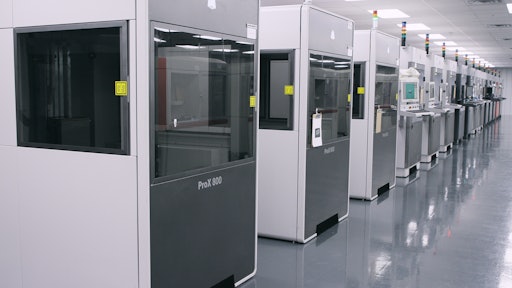
Over the last couple of years, manufacturers have been evolving their global supply chain structure to deal with disruption and uncertainty. However, the pandemic has put even the most resilient supply chains to the test. As the number of Coronavirus disease (COVID-19) cases increased, healthcare workers needed increased volumes of personal protective equipment (PPE) to treat patients. Additionally, the need for ventilators was growing exponentially and production lines came to a halt as raw materials were unavailable.
It was very apparent how the pandemic disrupted supply chains, but additive manufacturing (AM) was highlighted for its ability to rapidly produce the necessary items. Regardless of industry, manufacturers around the globe stepped up to help close the gap between supply and demand of desperately needed items. AM demonstrated its importance in the pandemic response efforts due to its promise of no tooling requirements, near-immediate design engineering and production response times and the ability to create new complex and custom geometries or reverse engineer existing parts. AM also fosters distributed manufacturing vs. a centralized supply chain fraught single-sourcing, complex logistics and long lead-times.
Delivering on the promise of 3D production
The role of AM has evolved over the years to a solution that enables end-to-end manufacturing workflows capable of delivering production-grade parts. Part quality, print speed, material properties and overall system costs have all improved to make direct production with AM a reality. This shift makes it possible to integrate AM into supply chains as a strategy to reduce the impacts of isolated or global disruptions. The power of direct production with AM enables a new, distributed manufacturing model using local manufacturing resources to answer local manufacturing needs.
For manufacturers that wish to embrace agile manufacturing, there are three key elements to consider. The first is to reduce dependencies on the existing ways of doing things. This includes everything from traditional production methodologies and product development cycles to supplier relationships, inventory management and in-house talent.
As manufacturers re-think and refine their processes, they must ensure production quality, repeatability and traceability no matter what technology they use. Becoming more agile means being able to adapt more quickly, but manufacturers must not sacrifice the quality products customers have come to depend upon.
Finally, these solutions must be streamlined and powered by the right software solutions to maximize productivity and flexibility. Currently, software on the manufacturing floor is often used for discrete functions or steps in the entire workflow. The most innovative manufacturers are beginning to incorporate software into their entire manufacturing workflow as the digital thread that integrates the discrete steps into a comprehensive process.
The path to agility
When integrating AM into their current environment, manufacturers are generally following one of two paths. The first is to be AM-ready by planning for AM as a production alternative if the need to pivot arises. In this case, it’s most efficient to partner with a service bureau that can offset capacity as needed.
The second option is to fully embrace AM on-site as part of their manufacturing workflow. Whether outsourcing or bringing the capability in-house, testing and verification of AM materials and processes for the application in question will be part of getting set up.
While the process can initially seem daunting, taking a step-by-step approach to adopting AM as part of a manufacturing workflow will set you on the right path:
· Identify how AM will be utilized within the manufacturing environment. Will it be a contingency for intermittent use only or to support product diversification?
· Identify the application(s) AM will support, and then design the part and select the material to meet the need. AM is a great solution, but it is not the best solution for every application. Beginning by understanding what the final part will be helps to select the most appropriate material and qualify the process.
· Begin with indirect manufacturing workflows before developing end-use parts. If a manufacturer is not experienced with production AM applications, starting with producing jigs and fixtures serves as a good proving ground with the benefit of customizing and accelerating production lines. When AM has proven its merits, transition to full production applications.
· Integrate the right manufacturing technologies and software solutions to streamline the entire workflow. 3D printing technology and materials are just parts of the entire manufacturing workflow. Software plays a very important role as the “glue that holds the entire workflow together” and facilitates the transition from one step to the next.
· Consider starting by outsourcing AM. For manufacturers not experienced with AM, or not sure if the investment is something they are poised to undertake, working with a service bureau will help address shifts in demand and capacity. That same partner will most likely also be a great resource when ready to integrate AM fully into an on-site workflow. Their experience and expertise will facilitate design of the best solution to meet the business’ needs.
Business in the “New Normal” has undoubtedly changed, and businesses open to change – and able to change – are those that will thrive. Integrating AM into the supply chain is a strategy to pivot faster and more effectively in response to future disruptions and emerging manufacturing needs. The ability to remain agile is the key to the future business health – and competitive advantage – of industry-leading innovators.

























